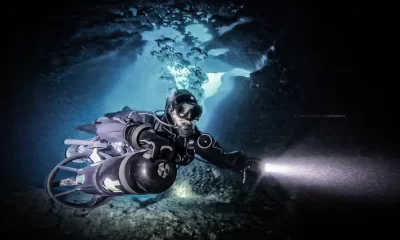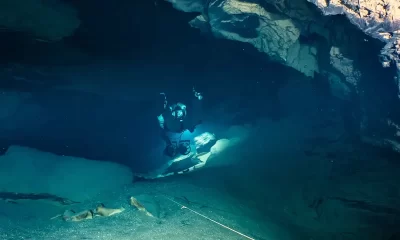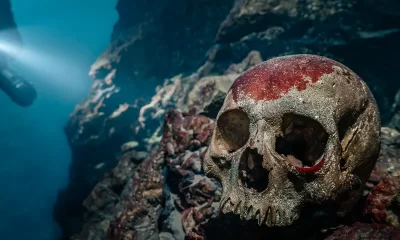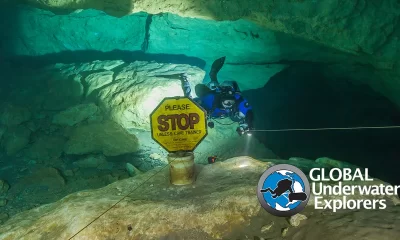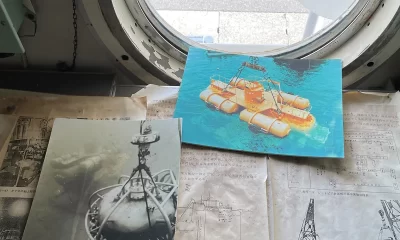Cave
N=1: The Inside Story of the First-Ever Hydrogen CCR Dive
On Valentine’s Day, Dr. Richard Harris, aka ‘Dr. Harry,’ and the Wetmules made the first reported hydrogen (H2) rebreather dive to a depth of 230m/751 ft, in The Pearse Resurgence, New Zealand. The 13 hour dive, which was nearly two years in planning, was a field test to determine the efficacy of using hydrogen to improve safety and performance on über-deep tech dives. Harris’s dive was the deepest “bounce” dive in approximately 54 experimental H2 dives—the majority SAT dives—that have been conducted over the last 80 years by military, commercial and, yes, a group of technical divers. Now in this first published account, InDEPTH reporter Ashley Stewart details the inside story behind the dive, a dive that will arguably be remembered 100 years from now!
By Ashley Stewart. Images courtesy of Simon Mitchell unless noted.
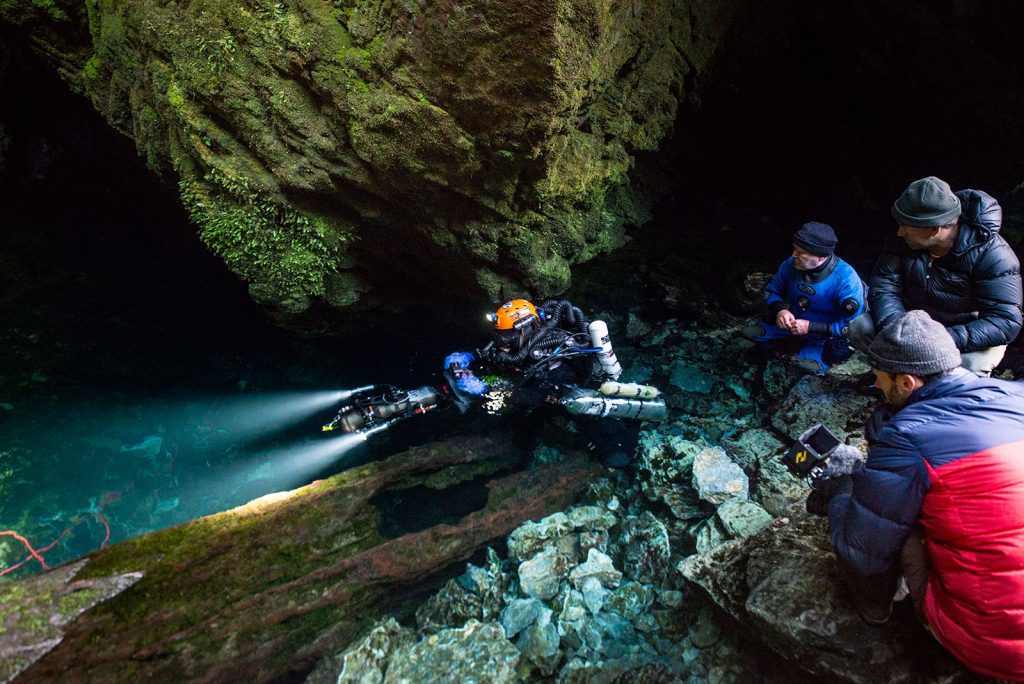
On March 11, a little more than three weeks after completing what is believed to be the first-ever rebreather dive with hydrogen as a diluent gas, Dr. Richard “Harry” Harris convened the group of scientists and researchers who had spent years helping to plan the attempt.
He started with an apology. “All of you had the sense that you were party to this crime, either knowingly or suspecting that you were complicit in this criminal activity,” Harris, an Australian anesthesiologist and diver known for his role in the Tham Luang Cave rescue, told the group.
The apology came because the dive was dangerous—not just to Harris who was risking his life, but for the people who supported him were risking a hit to their reputations and worried their friend may not return home. Harris and his team put it all on the line to develop a new technology to enable exploration at greater depths.
A significant challenge to deep diving is an increased work of breathing and CO2 buildup as breathing gas becomes more dense at greater depths. This can not only culminate in fatal respiratory failure but also increases the risk of practically everything else divers want to avoid, like inert gas narcosis and oxygen toxicity. For this reason, helium is favored by divers for its low density and non-narcotic effect. However, at such great depths, helium increases the risk of tremors and seizures from High Pressure Nervous Syndrome (HPNS). This can be ameliorated by keeping a small amount of narcotic nitrogen in the mix. The problem is that even small amounts of nitrogen makes the mix too dense past 250 meters.
Harris’s experiment would determine if divers can turn to an even lighter gas: Hydrogen, the lightest in the universe. Hydrogen is about half the density of helium. It’s also slightly narcotic and hence thought to ameliorate HPNS, thus allowing elimination of nitrogen from the mix.

The addition of hydrogen into a breathing gas, however, comes with one small technical uncertainty—the extremely explosive nature of hydrogen. History confirmed this reality with the 1937 Hindenburg disaster in which the hydrogen-filled dirigible airship burst into flames. As Harris tells it, he set out to dive hydrogen in his diluent gas while avoiding the nickname “Hindenburg Harry.”
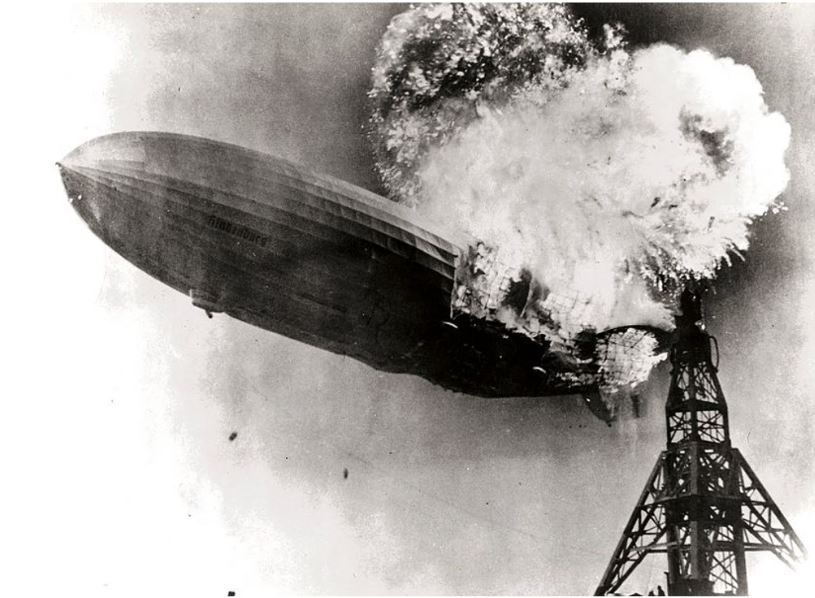
Hydrogen in the Mix
Why would anyone attempt to breathe hydrogen? Harris and his colleagues have spent more than a decade and a half exploring the Pearse Resurgence cave system in New Zealand. This extremely challenging, cold water cave system (water temperature is 6ºC/43ºF) has been explored by Harris and his team, who call themselves the Wetmules, to a maximum depth of 245 meters/803 feet in 2020. Their gas density at depth was 7.2 g/l, significantly above the recommended hard ceiling of less than 6.2 g/l.
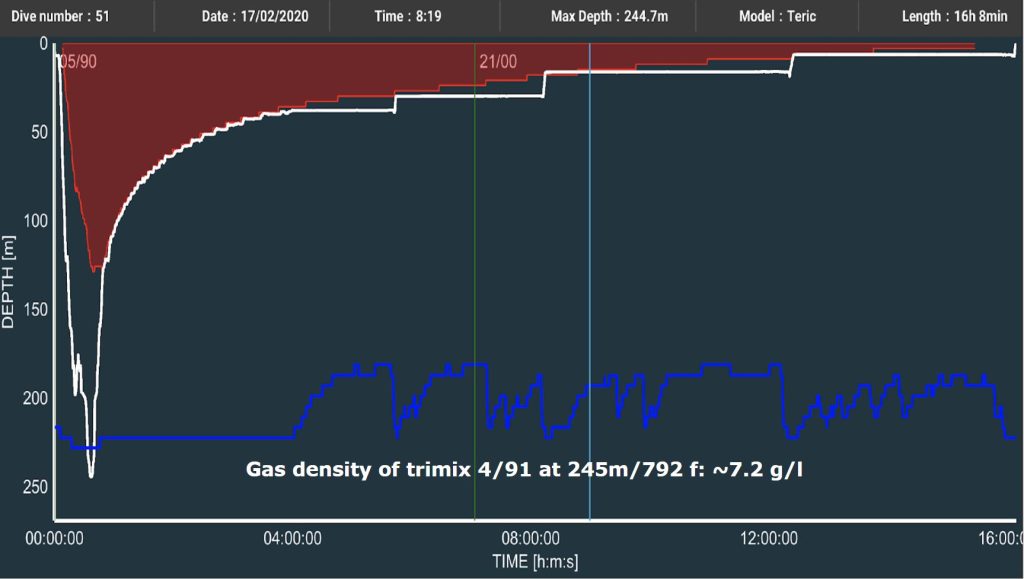
Diving past this point introduces increased risks, not only of CO2 buildup, but narcosis, decompression sickness, HPNS, cold breathing gas, having adequate gas supply or bailout, and isobaric counter diffusion (ICD) in which different gasses diffuse into and out of tissues after a gas switch causing bubble formation and related symptoms, cold breathing gas, and having adequate gas supply or bailout.

Divers have been examining hydrogen as a breathing gas for decades. The Swedish Navy was the first to experiment with hydrogen as a possible deep diving gas during World War II. The U.S. Navy in a 1965 paper proposed replacing helium with hydrogen due to projected helium scarcity. Later, beginning in 1991, researchers at the Naval Medical Research Institute (NMRI) in Bethesda, Maryland spent a decade studying hydrogen’s potential physiological impacts and biochemical decompression. French commercial diving contractor Comex (Compagnie maritime d’expertises) launched its hydrogen program in 1982, and the Undersea Hyperbaric Medical Society (UHMS) held a workshop “Hydrogen as a Diving Gas,” in 1987.
Even technical divers considered hydrogen. Legendary cave explorer Sheck Exley considered hydrogen in the early 1990s to mitigate HPNS symptoms, which are ultimately believed to have contributed to Exley’s death at Zacatón in 1994. Nearly all of the experimental hydrogen work up until this point used surface-supplied systems and saturation diving versus self-contained diving, and none of it, as far as we know, has been done with a rebreather.

The primary objective of Harris’ hydrogen experiment was to address the issue of increased work of breathing. Harris’s team had previously encountered CO2 incidents at the Pearse Resurgence. In one incident, while at 194 meters/636 feet, explorer Craig Challen—Harris’s primary dive buddy since 2006—lost buoyancy but was unable to find his buoyancy compensating button quickly. He kicked up a couple of times to stop his descent and immediately got a CO2 hit. Challen was able to grab the wall, calm down, slow his breathing, and survive. Based on such incidents, it’s clear to the team that they have reached the limits of the gas. “I feel we are on the knife edge all the time,” Harris said, in terms of physiology and equipment.
While hydrogen in the diluent breathing mix was expected to address increased work of breathing, the rest of the issues associated with deep diving were “major unknowns,” and some (such as respiratory heat loss) were potentially even made worse by hydrogen.
“At what depth do the risks of introducing this new technology outweigh the risks of carrying on with trimix?” Harris said. “That’s a very difficult question to answer. At some point we are going to have to consider different technologies and, at this point, hydrogen is perhaps the only one available to us.”
H2 Working Group
In 2021, the year after Harris completed his deepest dive at the Pearse Resurgence, InDepth editor-in-chief Michael Menduno was taking a technical diving class and reading about the government looking at hydrogen as a diving gas again. “Technical divers should be at the table,” Menduno said he thought to himself at the time, “our divers are as good as anybody’s.” He called John Clarke, who had spent 27 years as scientific director of the U.S. Navy Experimental Diving Unit (NEDU), and discussed setting up a working group. Menduno’s next call was to Harris, who had shared his troubles with gas density at the Pearse Resurgence. Harris had also, separately, been thinking about hydrogen.
The so-called H2 working group met for the first time in May 2021 and included many of the top minds in diving medicine and research, including Clarke, NEDU’s David Doolette and Greg Murphy, research physiologist Susan Kayar who headed up the US Navy’s hydrogen research at the Naval Medical Research Institute (NAMRI), along with her former graduate student Andreas Fahlman. There was diving engineer Åke Larsson who had hydrogen diving experience, deep-diving legend Nuno Gomes, decompression engineer JP Imbert who had been involved in COMEX’s Hydrogen diving program, and anesthesiologist and diving physician Simon Mitchell. The group was later joined by Vince Ferris, a diving hardware specialist from the U.S. Navy, and explorer and engineer Dr. Bill Stone, founder of Stone Aerospace.
The working group met regularly with the goal of figuring out how one might possibly operationalize hydrogen for a deep technical dive using the Resurgence as an example. During one of their meetings, Clark used a breathing system simulator built for the Navy to predict how hydrogen would affect gas density in a closed circuit rebreather at depths to 300 meters/984 feet.
To Doolette, who has known Harris for decades and supervised his Diploma of Diving Medicine project in 2001, it was immediately clear this was not a hypothetical discussion. “Unlike some of the scientists, I was under no illusion that the question before the working group was fiction, I knew that Harry was likely to try a H2 technical dive in the Pearse Resurgence,” said Doolette, a cave explorer in his own right, who has laid line in the Resurgence.
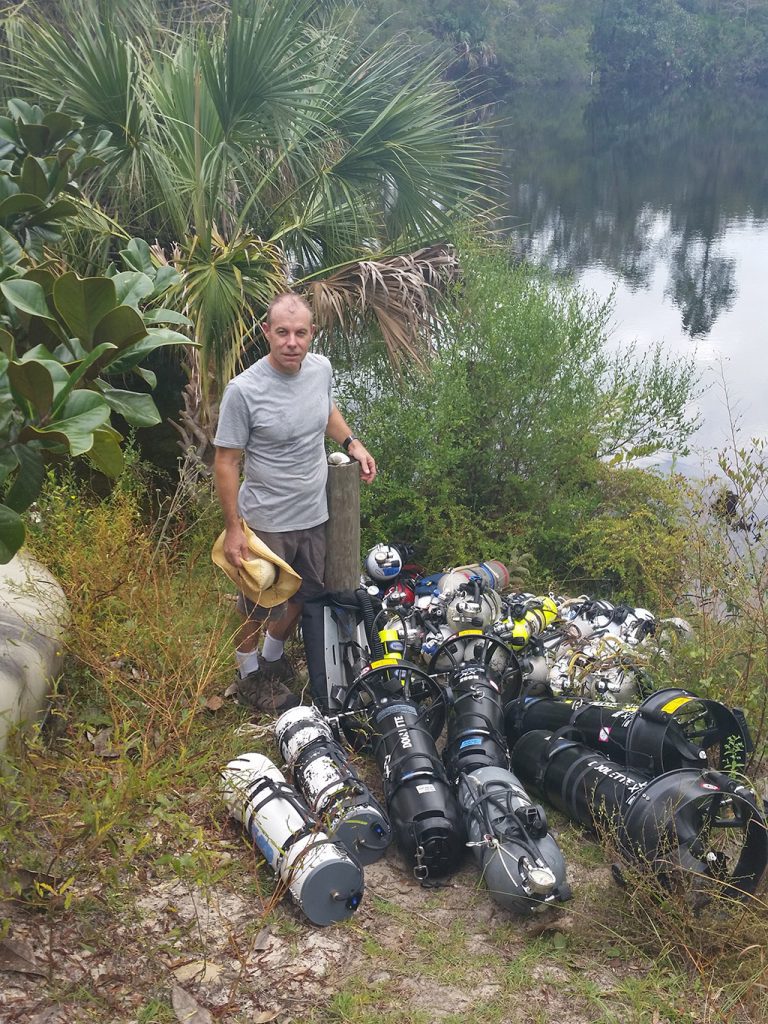
By fall of 2022, it was clear to many in the group that Harris was going to attempt the dive. The group had mixed feelings ranging from cautious optimism to comments like, “My friend is going to die.”
Doolette was concerned Harris and Challen would not survive the dive due to either ignition of hydrogen—in the worst case, inside the rebreather at depth—or a serious adverse response to respiratory heat loss (the latter was especially if Harris attempted diving beyond 245 meters/803 feet as he had originally planned) he said. “I have known Harry for longer than most in the group. I encouraged him to take up cave diving, so I felt a personal responsibility toward him,” Doolette said. “I have a lot of experience in operationalizing new diving technology. My goal was, if unable to discourage him, to force him to focus on the important issues.”
Leading up to the dive, Menduno scheduled Harris to give the banquet talk about the expedition at the Rebreather Forum 4 industry meeting in April. The outcome of the dive, of course, was uncertain, and the two had to make an alternate plan in the event that Harris did not return. “We had to say we were going to talk about your dive one way or another,” Menduno said. “If you don’t make it back, Simon Mitchell is going to have to give a presentation about what went wrong. Harry made some typical Harry joke like, ‘Well, as long as you don’t stop talking about me.’” Harris’s lighthearted tone betrays how seriously he took the dive and its preparation, people close to him said.
While no one involved was taking as big a risk as Harris and Challen, they were risking a hit to their professional reputations by being associated with a controversial dive, especially in the event of a tragic outcome.
“At heart, I’m an explorer, and that was pure exploration,” Mitchell, who was the diving supervisor on Harry’s dive, said when asked why he would take such a risk. “Exploration in the sense that we were pioneering a technique that hadn’t been used for quite some time and never in technical diving, not deep technical diving.” He also emphatically added, “I was more worried about my mate dying than about my professional reputation.”
Later, in planning Harris’s trip to the RF4 event, Menduno had occasion to speak to Harris’s wife, Fiona who brought up the dive.
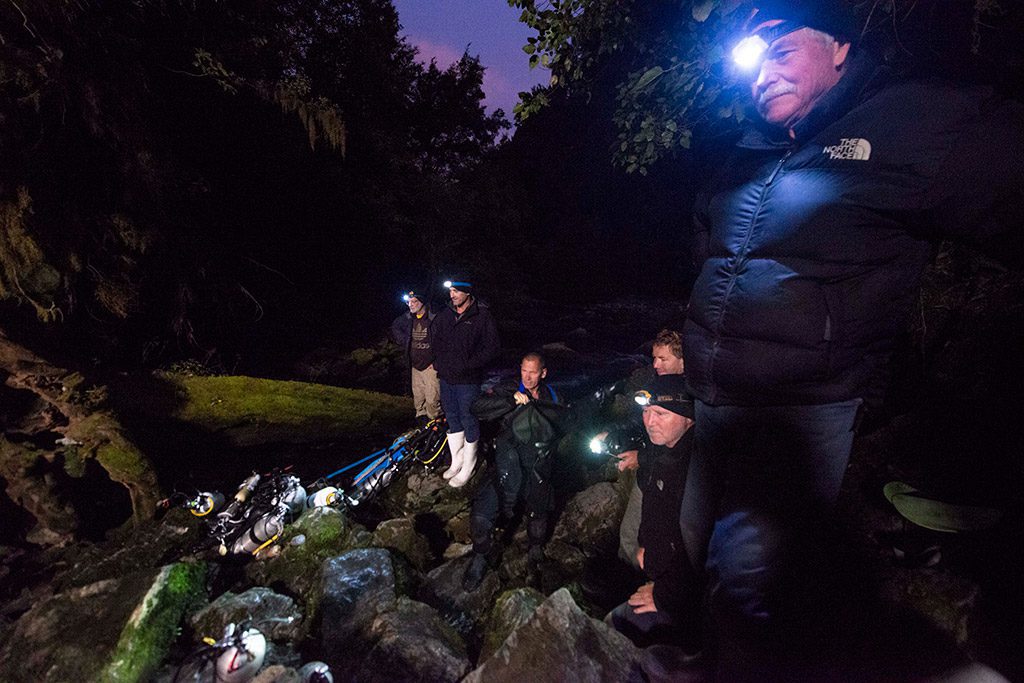
“She said to me ‘I hope Harry is going to be OK’,” Menduno said. “I had no idea how much Harry told her, what she knew and didn’t know. All I could say was he’s got the best people in the world on his team, and if anybody can do it, he can.”
“We all held our breath and waited,” Menduno said.
‘Hydrogen Trials’ at Harry’s House
Ahead of the dive, Harris was preparing at home. The first thing Harris said he had to get his head around was—no surprise—the risk of explosion, and how to manage the gas to mitigate that risk. The potential source of explosion that Harry was most concerned with was static ignition within the CCR itself, plus other potential ignition sources like electronics, the solenoid, and adiabatic heating. Industrial literature—or “sober reading” as Harris calls it—suggested that the tiny amount of static necessary to initiate a spark to ignite hydrogen is .017 mJ, 400 times less than the smallest static spark you can feel with your fingertips and several hundred times less than required to ignite gasoline. “It ain’t much, in other words,” Harris said, noting that counterlung fabric rubbing against itself could generate just such a spark.

Ultimately, Harris came across research that suggested that static decreases with humidity. “I started to feel like there was no source of ignition inside a rebreather, but then again I said to myself, ‘Harry you only need to be wrong once’.”
The other concern was whether he could actually fill hydrogen safely while decanting, or filling one tank from another at the same pressure, and boosting the gas to reach higher pressures.
“I decided there is only one way to actually resolve this and that is to retire to the shed, order a sneaky bottle of hydrogen, and without telling my wife what was going on down the back of the house, start to actually have a bit of a play with this,” Harris said.
First Harris had to make his own DIN fitting (though not out of the ordinary for the anesthesiologist who built and tested his own rebreather before buying a commercial one in 2002) to decant the gas. Next he took his dual Megalodon rebreather with 100% hydrogen in one diluent cylinder and 100% oxygen in the other to the “test bed” in his backyard—his pool—and started to introduce hydrogen into his rebreather.
“Putting an explosive device into water was perhaps not the most logical approach because it becomes more like a depth charge than a bomb, but I thought, ‘Well, at least it might contain the blast somehow into the pool.’ I knew if I broke the back windows in the house or worse, my life wouldn’t be at risk just from the hydrogen. There would be bigger trouble afoot,” Harris said. “I left the lid of the rebreather unclipped in the vain hope it would spare me and the pool and the dog, who was helping with this experiment.”

He pressed the button of the Automatic Diluent Valve (ADV) on his rebreather, introducing hydrogen to the loop, and finally activated the solenoid before he started breathing from it. The first breaths were pleasant, he said. “It did feel very light and very slippery, and the hydrogen voice is even sillier than the helium voice, as you would expect,” he said. “I don’t want people to rush away thinking this is a safe and sensible thing to do. I’m under no illusions I’ve produced any evidence for you to see, but this is an honest account of the hydrogen trials at my house.”
The unit had not exploded with a fill of oxygen from zero to 70%, and very low humidity. “Harry, dog, and CCR survive,” as Harry wrote in his report of the trials. “Nothing bad had happened, so it was reasonable to move to the next step,” he said.

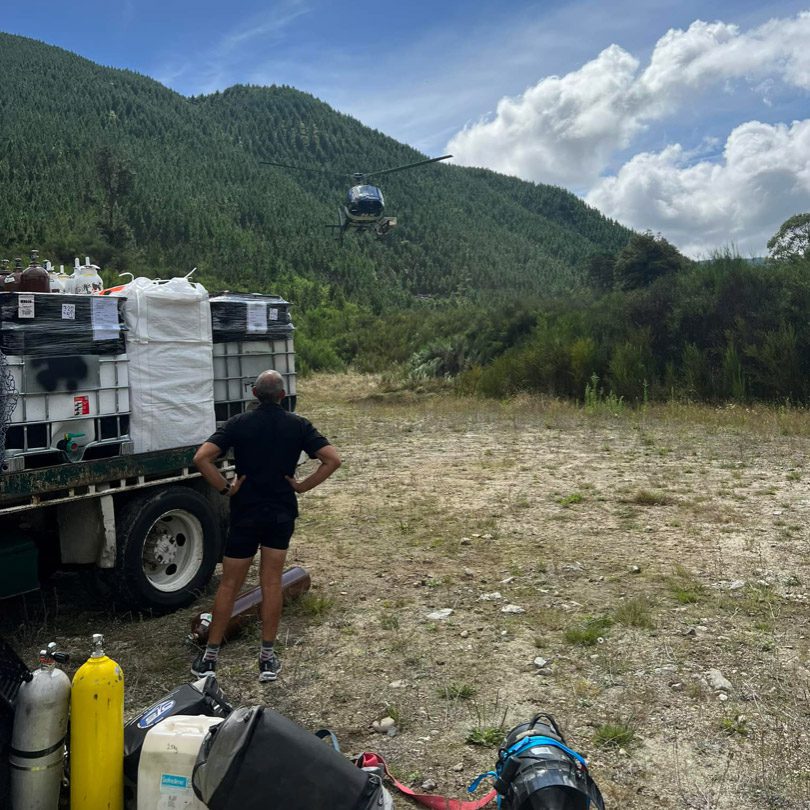
The Expedition
Harris, Challen, and other members of the Wetmules, arrived at the site of the Pearse Resurgence on New Zealand’s south island in February 2023. The cave system is so remote they needed around 10 helicopter trips to transport the team and all of its equipment. Mitchell, the diving physician, ran surface operations with “mixed feelings,” as Harris put it.
The group stayed for two weeks at a campsite, complete with a gas-mixing station, an electronics shelter for charging gear, and a “big green army tent where we meet and drink a lot of coffee and try and put off going back into the water each day,” Harris said.
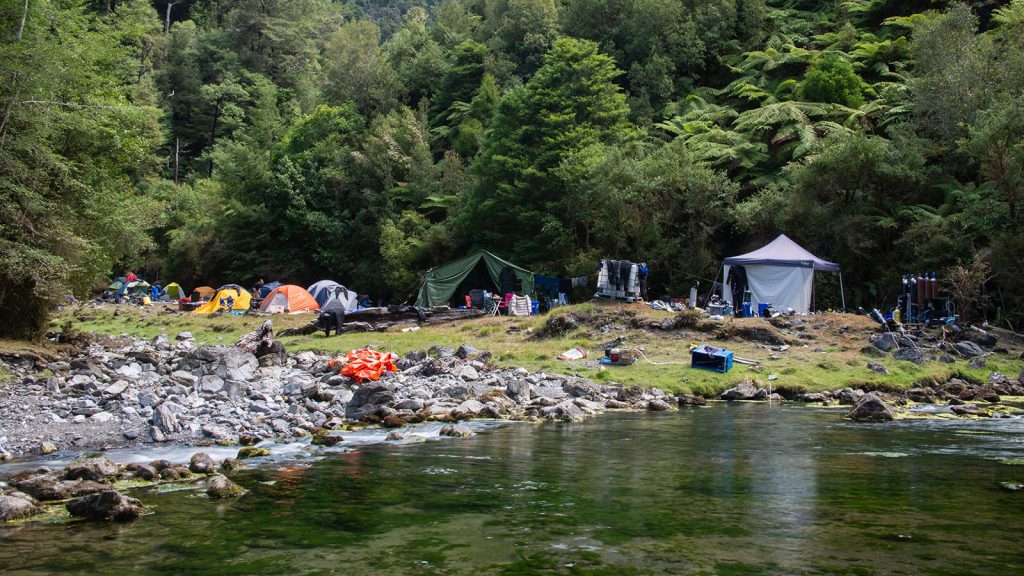
The expedition was plagued with an unheard of number of problems, Harris said, “Every time we got in the water, something popped or blew up or failed.” The campsite is where Harris boosted hydrogen for the first time, from 100 to 150 bar. He flushed the booster and all the whips with hydrogen prior to boosting to make sure no oxygen was left in the system, but it was an anxious moment.
On dive day, Harris and Challen set out on what would be a 13 hour dive to 230 meters/754 feet—a “comfortable depth,” as Harris put it. Due to some problems during the expedition, it was decided that Harry would dive hydrogen, while Craig would dive trimix. At 200 meters/656 feet depth, Harris pivoted the switch block to introduce hydrogen into the loop. “The first cautious sip of hydrogen just to activate the ADV was satisfying,” he said. Gas density was not subjectively improved, but Harris noticed an obvious benefit—the HPNS-induced hand tremors he typically experienced after 180 meters/590 feet disappeared. Harris kept his setpoint at .7 during the descent and working portion of the dive, careful not to reach a fraction of oxygen above 4% which would make the mix explosive, and proceeded to the 230-meter test depth.
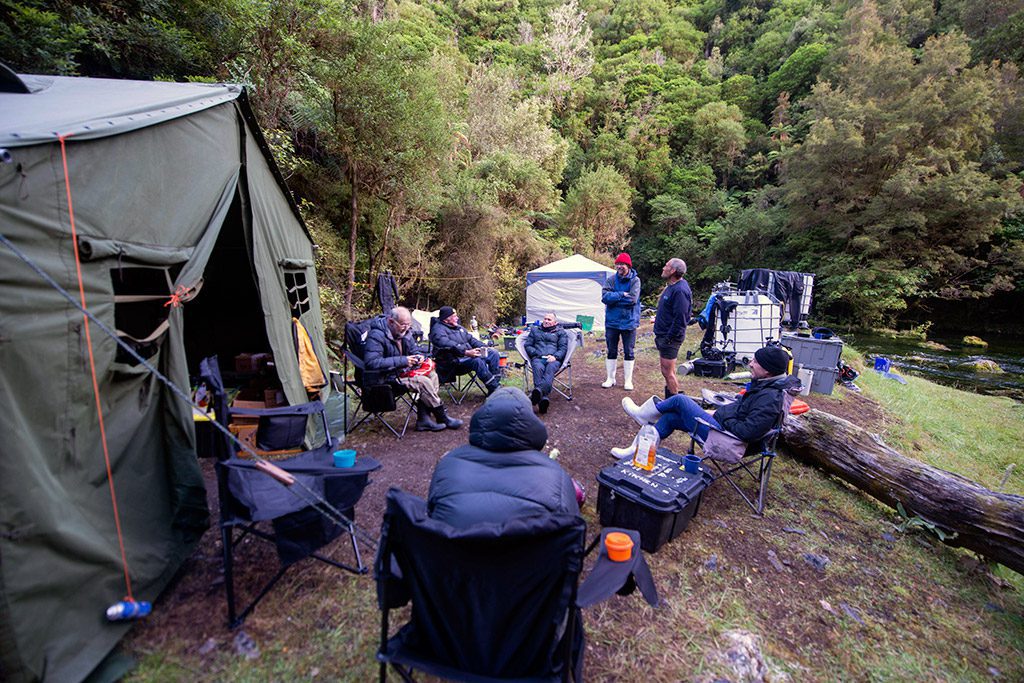

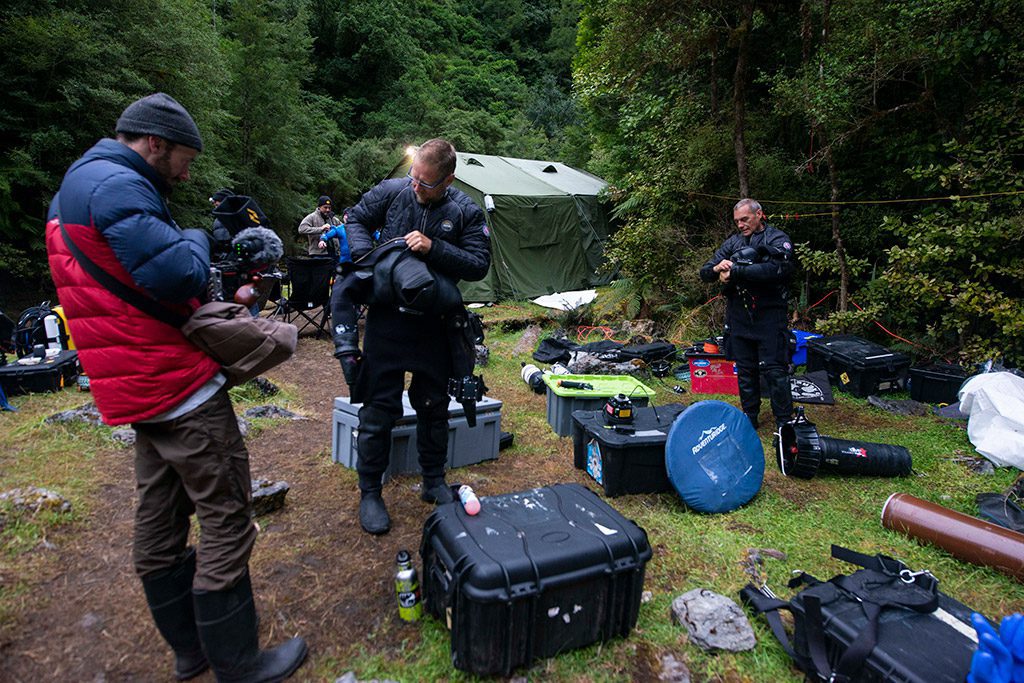
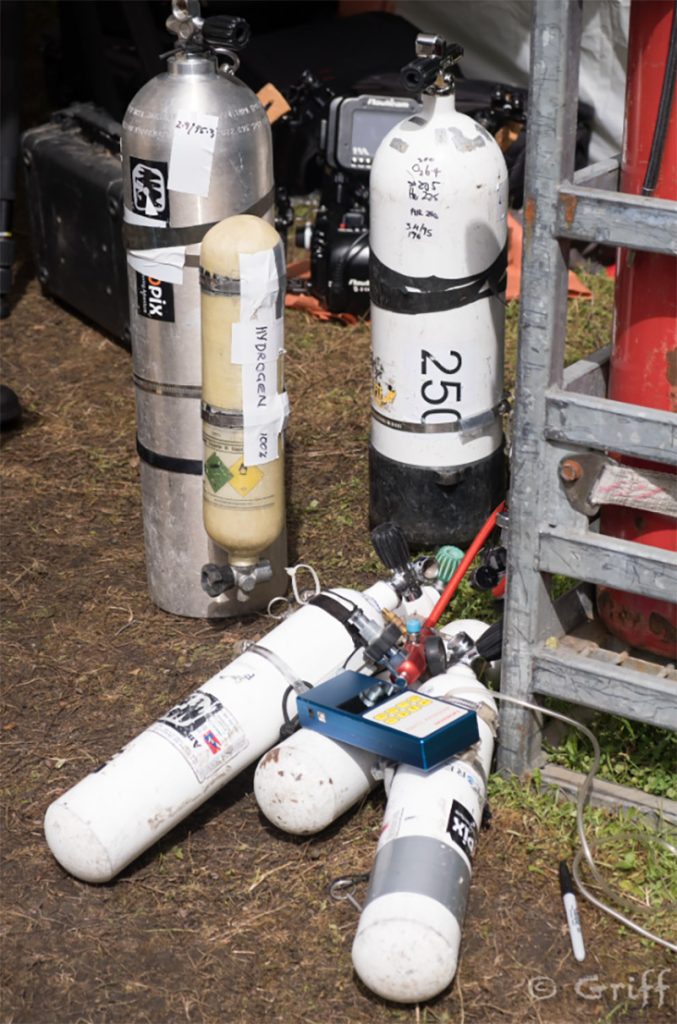

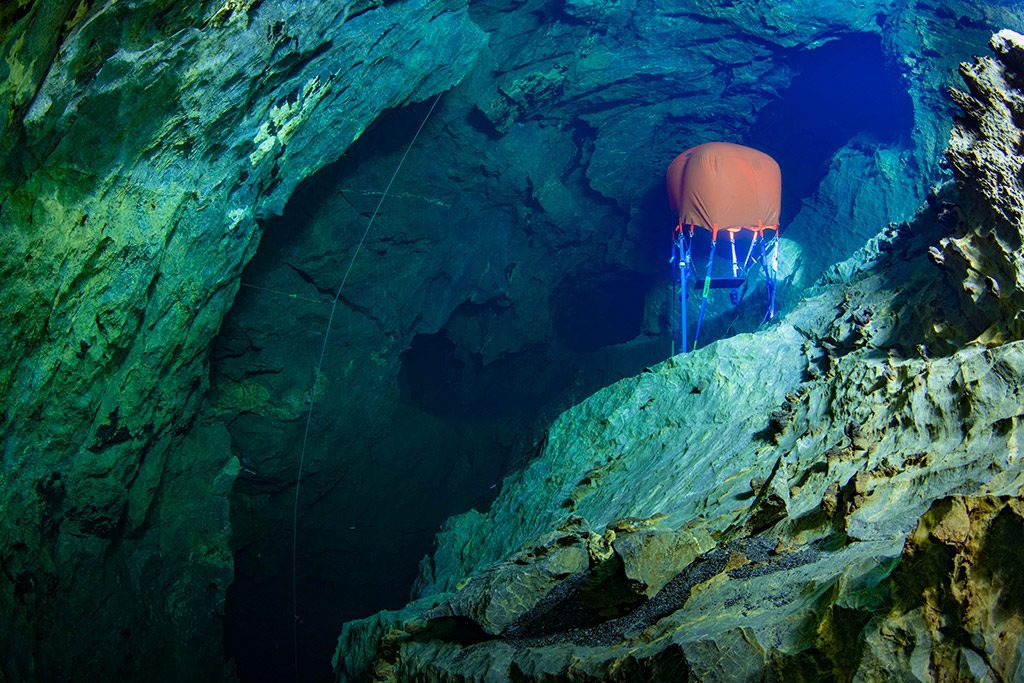
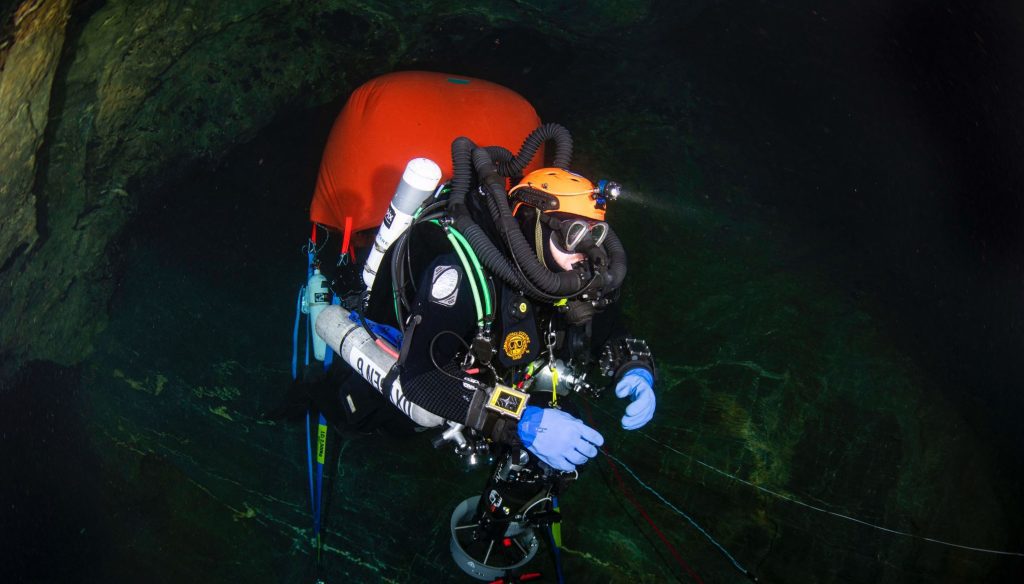
After completing their time at 230 meters, the team began their ascent. Harry shut off the hydrogen feed to the active loop of his dual Megalodon rebreather back at 200 meters, and then conducted a diluent flush every 10 meters/33 feet to remove the hydrogen from the loop until reaching 150 meters/492 feet. At that point, Harris boosted his PO2 to 1.3 from his set point of 0.7 (Challen remained at 1.3 throughout the dive), and they continued their ascent decompressing on a trimix (O2, He, N2) schedule, treating hydrogen as if it were helium. The complete technical details of the dive will be published in a forthcoming paper in the Diving and Hyperbaric Medicine Journal.
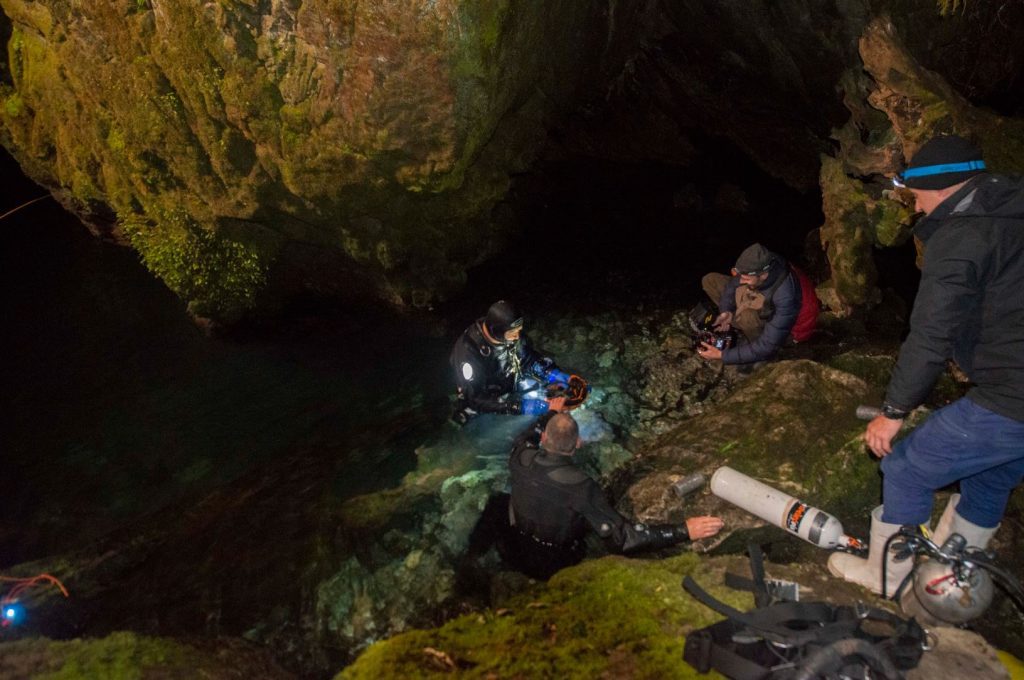
As soon as the team were helicoptered back to civilization, Harry called Michael from the road. “Michael, we did it!,” Harris said.
“Harry, you’re alive!,” Menduno responded.
N=1
At that March meeting with the H2 working group, Harris presented his findings from the dive. “I’m not sure what to conclude to a highly scientific, analytical, and evidence-based audience like yourselves,” he told the group. “Conclusions: N=1,” meaning it had been successful one time.
Doolette, who had been the most vocal in the group about his concerns, suggested Harris could add to his conclusions “the probability of survival is greater than zero.” Doolette, whom Mitchell contacted as soon as they reached civilization, said he “was relieved to hear that Harry survived this test dive” but remains disappointed with some aspects of the experiment, and concerned about possible future attempts. “For instance, I imagine among the engineers he consulted would have been someone with the ability and resources to do a computational fluid dynamic analysis of the Megalodon rebreather to establish the ignition risk, but instead Harry filled his rebreather up with hydrogen in his backyard.”
Overall, Harris said his findings are that hydrogen can be handled and boosted, hydrogen and CCR diving are compatible, a strategy to introduce hydrogen on descent was successful, a decompression dive was successful, a low setpoint at depth did not practically affect total dive time, strategy to reintroduce a high PO2 on ascent was successful, and HPNS and narcotic impacts were subjectively favorable.
“In introducing hydrogen we have addressed the issue of gas density, but we certainly have not established it is safe to use in terms of explosion risk, decompression, or the thermal hazards,” Harris said.
Among his conclusions, Harris pointed out that he also managed to evade the nickname “Hindenburg Harry.” “Fortunately that was avoided,” he said, “but remains an ever-present risk.”
The Future of H2
Harris warns not to read too much into what his team achieved—a single data point that should in no way encourage others to repeat the dive. “David Doolette’s comment should be heeded,” Harris said. “All we have shown is that we got away with it on one occasion.”
Provided it can be safely proven and built upon, Harris said he thinks of his hydrogen dive as a window into the future that would enable tech divers to continue exploring into the 250 to 350 meter/820 to 1148 feet range. “Imagine the wrecks and caves that lay unvisited around the planet,” Harris said.
See companion story: Hydrogen, At Last by Michael Menduno and Dr. Harry’s presentation at RF4: N=1, the World’s First Hydrogen CCR Dive
DIVE DEEPER
Diving Talks: The first deep rebreather dive using hydrogen: a gateway to deep exploration? by Simon Mitchell
YouTube: Wetmules 245m Cave Dive in the Pearse Resurgence, New Zealand (2020)
InDEPTH: Density Discords: Understanding and Applying Gas Density Research by Reilly Fogarty
InDEPTH: Playing with Fire: Hydrogen as a Diving Gas by Reilly Fogarty
InDEPTH: High Pressure Problems on Über-Deep Dives: Dealing with HPNS by Reilly Fogarty
InDEPTH: The Case for Biochemical Decompression by Susan Kayar
John Clarke Online: Hydrogen Diving: The Good, The Bad, the Ugly (2021)
InDEPTH: Diving Beyond 250 Meters: The Deepest Cave Dives Today Compared to the Nineties by Michael Menduno and Nuno Gomes.
Undersea Hyperbaric Medical Society: Hydrogen as a Diving Gas: Proceedings of the 33rd UHMS Workshop Wilmington, North Carolina USA (February 1987)

InDepth Managing Editor Ashley Stewart is a Seattle-based journalist and tech diver. Ashley started diving with Global Underwater Explorers and writing for InDepth in 2021. She is a GUE Tech 2 and CCR1 diver and on her way to becoming an instructor. In her day job, Ashley is an investigative journalist reporting on technology companies. She can be reached at: [email protected].



















